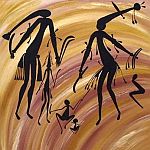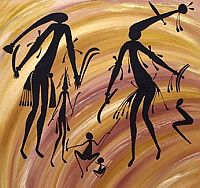Wikipedia
R.H. Allen:
Star Names
Ian Ridpath:
Star Tales
Universe Guide
Sea and Sky:
The Constellations
IAU
Map
NASA:
Constellations
|
Wikipedia |
R.H. Allen: Star Names |
Ian Ridpath: Star Tales |
Universe Guide |
Sea and Sky: The Constellations |
IAU Map |
NASA: Constellations |


|
|
Star LorePleiadesPart 4 - Africa and Australia |
|


 Dreamtime
Dreamtime |
Named after the seven daughters of Atlas and Pleione in Greek mythology, the Pleiades are arguably the star formation
with the most recorded star lore. The star cluster is a prominent sight in winter in the Northern Hemisphere. The Pleiades have been observed by humans at least since the Bronze Age. |


Africa |

|
|
G//ana
The G//ana people of southern Africa consider
Sirius (α CMa) and Canopus (α Car)
the husbands of the Pleiades.
|


|
|
Maasai
The Maasai call May the Month of the Pleiades. The disappearance of the Pleiades from the sky signals the end of the rain season.
|


|
|
Nama
For the Nama, Orion's Belt represented three Zebras. One day, the Khunuseti (the Pleiades) asked their husband Aob,
which is Aldebaran (α Tau) to shoot the Zebras.
Aob fired his arrow (Orion's Sword) but fell short of his target. He did not dare to retrieve his arrow because of the fierce lion (Betelgeuse) which sat watching
the zebras and he dared not return home because he had killed no game. Thus, there he sits forever, shivering in the cold night and suffering thirst and hunger.
|


|
|
Swahili
In Kiswahili, the Pleiades are called Kilimia, the Ploughing Stars or Digging Stars. The first appearance of the
Pleiades in June
is the beginning of the digging and growing season.
|


|
|
Sotho
In Sesotho, the Pleiades are called Seleme se setshehadi, meaning "the female planter".
Their disappearance in April (the 10th month) and the appearance of Achernar (α Eri) signals the
beginning of the cold season.
|


|
|
Tuareg
The Tuareg Berbers of the northern Sahara call the Pleiades Cat iheḍ or ahăḍ, meaning "daughters of the night".
|
 Sahara Night; jaydearchives.com
Sahara Night; jaydearchives.com
|
This refers to the season during which the Pleiades rise and fall. When they "fall" with the sun on the west, it roughly means the hot, dry summer
is coming. When they rise from the east with the sun, the cold somewhat rainy season is coming. (Due to
Precession, these meanings may fade in the future.
 To many other Berber nations, the Pleiades are known as Tagemmunt. meaning "the group"  Source: Wikipedia |


|
|
Xhosa
The Xhosa too call the Pleiades the Digging Stars - IsiLimela. The new year begins in June with the first appearance of the
Pleiades.
|


Australia |
|
|
The Maya-Mayi
One of the most popular Aboriginal dream time stories circulation on the internet it the myth of the Maya-Mayi. Unfortunately, everywhere we
looked, the story is referenced only as "Australian" without information of which of the 400 Australian Aboriginal nations can be credited.
The stars we now call the Pleiades were once seven beautiful sisters called the Maya-Mayi. Every man who ever saw them wished that he could marry one of them.
|

|
Warrumma crept close to the sisters. He quietly reached out his hand and took two of their digging sticks and then retreated to his hiding place.
 The five sisters who could find their sticks continued to gather food, but the two who couldn't find theirs stayed behind. Warrumma jumped up from his hiding place and seized both girls around their waists, holding them firmly. They screamed loudly but no one heard. They struggled but Warrumma was so strong. When they had finally stopped screaming and struggling, Warrumma explained that he was lonely and that he would take care of them and that he wanted to marry them.  The two girls travelled with him, but always looked for a chance to escape. One day their chance came.... Wurrumma had stopped for lunch. ”Strip some bark from those two trees,” he ordered, “so I can build a fire.” |

So each sister swung her stone axe into a tree. The axes stuck fast, and two trees began to grow. They quickly rose higher and higher with the sisters clinging to their axes until the trees had reached heaven.
 Then the other five sisters appeared in the sky and helped the two in the trees to climb up and join them amidst the clouds. Those seven sisters turned into stars in the night sky, which are called the Mayamayi by the Australian Aborigines.  If you look closely at the constellation, you may see the two freed sisters, just arriving at their sister’s camp in the sky.  And as for lonely Wurrumma, why, he’s STILL looking for a wife.  Source: Mother Goose Australia |
 Seven Sisters
Seven SistersSource: Marlene Doolan |


|
|
Adnyamathanha The Adnyamathanha in South Australia show two asterisms in their national flag: The southern part of Orion is called Mirarrityi, meaning The Saucepan and the Pleiades are Artunyi or The Seven Sisters. Mirarrityi (Orion) represents Miru Muda, the Men’s story line, Artunyi represents Artu Muda, the Women’s story line. |
 Adnyamathanha flag
Adnyamathanha flagSource: Flags of the World |
They are both placed in the sky, called Ngiiarri, while the Sun is placed in the land, called Yarta.
 A long time ago the Artunyi were the wives of an old Akurra, a giant creation water serpent who created much of the lands and waters upon the land. Akurra was very jealous because the Artunyi were all very beautiful women. One day, while his wives were swimming in an Awi-urtu (water-hole) some men (Yura Miru) came along, saw them and immediately fell in love with them and wanted to take them for their wives. The old Akurra snuck up on the Yura Miru. He then came up from beneath the water hole, swallowed all seven of his wives and immediately spat them out of his mouth high up into the sky, so that his wives would forever be out of the reaches and clutches of the Yura Miru.  The part of the sky where the Artunyi now reside is called Wali Vari, meaning home creek. The Adnyamathanha believe it is the spiritual home they return to when they die.  Source: Aboriginal Astronomy |


|
|
Boorong
In Boorong mythology, the Pleiades are a group of young women called Larnankurrk.
|
 Source: Aboriginal Art Library
Source: Aboriginal Art Library
|


|
|
Torres Strait Islanders
In the story of creation hero Tagai and his crew mates (see Centaurus), Tagai kills twelve of his crew mates in rage. But
since his crewmates were spiritual beings, they could not die, but became stars instead.
|
 Six men hang on a seg (Orion)
Six men hang on a seg (Orion)
|


|
|
Wurundjeri The Wurundjeri people in south central Victoria tell the story of the Karatgurk and Waa, the crow. The Karatgurk were seven sisters who lived by the Yarra River where Melbourne now stands. In the Dreamtime, the Karatgurk alone possessed the secret of fire. Each one carried a live coal on the end of her digging stick, allowing them to cook the yams which the dug out of the ground. The sisters refused to share their coals with anybody. |
 Seven Sisters Dreaming
Seven Sisters Dreaming© Alma Granites |
One day Crow found a cooked yam and, finding it tastier than the raw vegetables he had been eating, decided
he would cook his food from then on. However, the Karatgurk women refused to share their fire with him and Crow resolved to trick them into giving
it up. Crow caught and hid a number of snakes in an ant mound then called the women over, telling them that he had discovered ant larvae were far
tastier than yams.
 The women began digging, angering the snakes, which attacked. Shrieking, the sisters struck the snakes with their digging sticks, hitting them with such force that the live coals flew off. Crow, who had been waiting for this, gathered the coals up and hid them in a kangaroo skin bag. The women soon discovered the theft and chased him, but the bird simply flew out of their reach, and this fire was brought to mankind.  Afterwards, the Karatgurk sisters were swept into the sky. Their glowing fire sticks became the Pleiades star cluster.  Sources: Wikipedia, Mythology Wikia |


|
|
Yolngu
The people on Millingimbi Island (part of the Yolngu language group) see the Pleiades as the wifes
of three brothers, represented by Orion's Belt. The the brothers are part of the
Yolngu myth of the Canoe in the Sky.
|


 |
Back to Asia and Pacific | Forward to The Americas |
 |


|
Back to Star Lore |
Back to Mythology |

Back to Pleiades |
Back to Space Page |
Back to English |
 Back to Start Page |